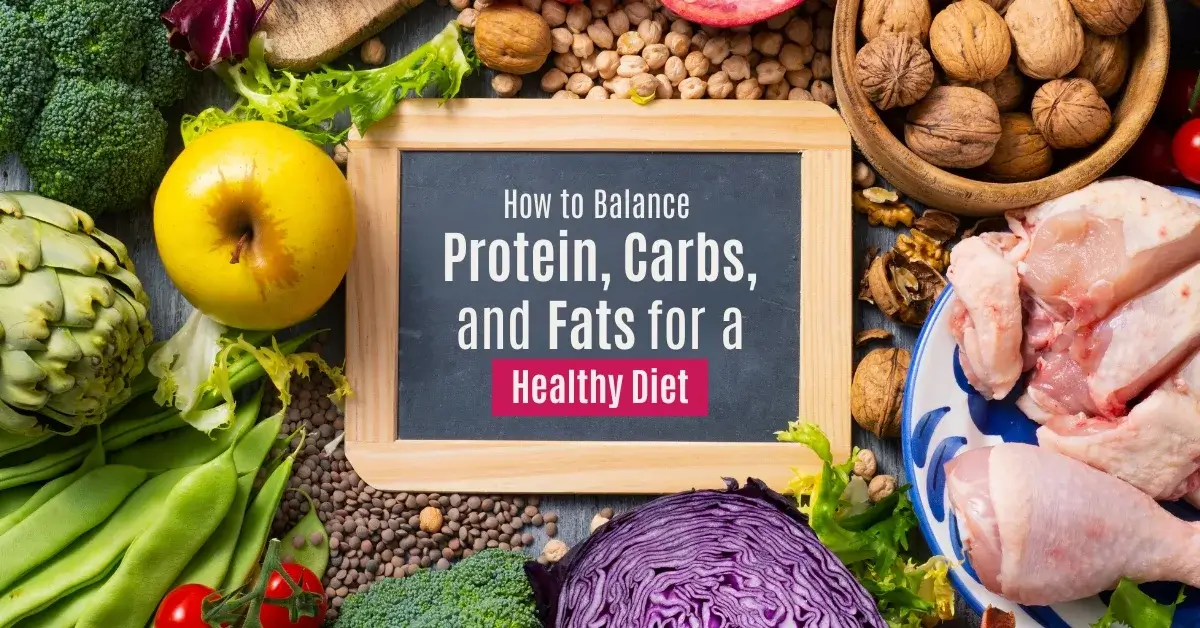Introduction
A healthy diet isn’t just about eating less or cutting out food groups. It’s about giving your body the right mix of nutrients in the right quantities. With trends like keto, low-carb, or high-protein diets flooding social media, many people end up confused or misinformed. In reality, the secret to long-term energy, improved metabolism, better digestion, and even weight loss is about balancing your macronutrients: protein, carbohydrates, and fats.
In this detailed guide, we’ll break down each macronutrient, their role in the body, how to include them through Indian foods, and how you can start eating in a more balanced, mindful way. You’ll also find a practical 7-day meal plan and FAQ section to help guide your journey.
Understanding Macronutrients: What Your Body Really Needs
Macronutrients are nutrients your body needs in large amounts. They give you energy and keep your body functioning properly. The three major macronutrients are:
- Protein: Crucial for muscle repair, immune function, and hormone production
- Carbohydrates: Your body’s primary fuel source
- Fats: Essential for brain function, hormone balance, and vitamin absorption
Let’s explore each of these in more depth.
1️⃣ Protein: The Muscle Builder and Satiety King
Protein isn’t just for gym-goers. It’s essential for everyone. From muscle repair and skin regeneration to enzyme function and hormones, protein plays a vital role. A diet lacking in protein can lead to fatigue, muscle loss, and poor immunity.
✅ Benefits of Protein:
- Keeps you full longer and helps reduce overeating
- Aids in post-workout recovery and muscle gain
- Supports hair, nails, and skin health
🍲 Indian Protein Sources:
- Vegetarian: Lentils (dal), rajma, chana, moong, paneer, curd, tofu, quinoa, soybean, Greek yogurt, nuts and seeds
- Non-Vegetarian: Eggs, chicken breast, mutton (lean cuts), fish (rohu, salmon, mackerel)
💡 Combine pulses with grains like dal and rice to get a complete amino acid profile, especially important for vegetarians.
📏 The average adult needs 0.8–1.2g of protein per kg of body weight daily. For example, if you weigh 60 kg, aim for 50–72g of protein.
2️⃣ Carbohydrates: Your Brain’s Favorite Fuel
Carbs have been wrongly demonized in recent years. Yes, refined sugars and white bread aren’t the healthiest, but complex carbs are essential for energy, brain function, and mood regulation.
✅ Why You Need Carbs:
- Provide energy for physical activity and daily tasks
- Support digestion with dietary fiber
- Help regulate blood sugar when paired with protein and fat
🍚 Healthy Indian Carb Sources:
- Whole grains: Brown rice, whole wheat roti, oats, barley, millet (ragi, jowar, bajra), dalia
- Vegetables: Sweet potatoes, carrots, beetroot, pumpkin
- Fruits: Bananas, apples, oranges, mangoes, papayas
- Legumes: Moong, chana, rajma (offer both carbs and protein)
📏 Carbs should make up 45–55% of your total daily calories. Prioritize fiber-rich, low-GI carbs to prevent sugar spikes and crashes.
💡 Post-workout is a great time for simple carbs like fruit when your body can use them for recovery.
3️⃣ Fats: Don’t Fear the Good Fats
Fat doesn’t make you fat. Excess calories do. In fact, fats are essential for brain health, hormone production, cell repair, and absorbing fat-soluble vitamins like A, D, E, and K.
✅ Role of Fats:
- Help absorb vitamins and minerals
- Support brain development and memory
- Regulate body temperature and protect organs
🥥 Healthy Indian Fat Sources:
- Traditional: Desi ghee (in moderation), mustard oil, coconut oil
- Modern: Olive oil, avocado, nut butters
- Nuts and Seeds: Almonds, walnuts, chia, flaxseed, pumpkin seeds
- Animal-based: Fatty fish, egg yolks, full-fat dairy
📏 Fats should contribute 20–35% of your daily calories. Prefer unsaturated fats and limit trans or deep-fried options.
How to Balance Protein, Carbs, and Fats for a Healthy Diet
To create a truly healthy diet, think of your plate as a puzzle. Every meal should ideally have a mix of all three macronutrients.
⚖️ Suggested Macro Ratios:
- Weight Loss: 40% protein, 40% carbs, 20% fats
- Muscle Gain: 30% carbs, 50% protein, 20% fats
- Maintenance: 50% carbs, 30% protein, 20% fats
🕒 How to Distribute Your Nutrients:
- Breakfast: Protein and moderate carbs (e.g., oats with curd and seeds)
- Lunch: Balanced macros (e.g., dal, rice, sabzi cooked in mustard oil)
- Dinner: Lighter carbs, more protein (e.g., tofu stir-fry with roti)
| Day | Breakfast | Lunch | Dinner |
| 1 | Moong dal chilla + curd | Rajma + brown rice + salad | Stir-fried paneer + chapati |
| 2 | Poha + peanuts | Roti + dal + ghee + sabzi | Grilled fish + sautéed veggies |
| 3 | Vegetable upma | Khichdi + curd | Chana salad + multigrain toast |
| 4 | Besan chilla | Bajra roti + paneer bhurji | Masoor dal soup + sautéed tofu |
| 5 | Idli + coconut chutney | Jeera rice + mix veg dal | Curd rice + cucumber salad |
| 6 | Overnight oats with fruits | Soya curry + quinoa | Grilled chicken + veggie stir fry |
| 7 | Dalia + almonds | Vegetable biryani + raita | Palak paneer + chapati |
✅ 7-Day Balanced Indian Meal Plan📌 Adjust portion sizes, spice levels, and ingredients based on your goals and preferences.
🚫 Common Mistakes to Avoid
❌ Skipping Carbs Completely: This leads to low energy and mood swings
❌ Excess Protein: Your body stores unused protein as fat
❌ Avoiding All Fats: Healthy fats support hormones, skin, and brain function
❌ Over-relying on Packaged Foods: Whole foods always win
💬 Frequently Asked Questions (FAQs)
1. Can I lose weight by just reducing carbs?
You can lose weight, but cutting carbs drastically isn’t sustainable. A better approach is to reduce refined carbs and focus on whole grains and fiber-rich options.
2. What’s the best macronutrient ratio for fat loss?
A common fat loss macro split is 40% protein, 30% carbs, 30% fats, but this varies per person. It’s best to consult a nutritionist to tailor it to your needs.
3. How do I calculate my macros easily?
You can consult a certified nutritionist or dietitian to determine your exact needs based on age, activity, and goals.
4. Can vegetarians get enough protein?
Yes. Indian vegetarians can meet their protein needs with dals, legumes, paneer, tofu, quinoa, soy, and dairy. Pairing grains with pulses improves the protein quality.
5. Is ghee healthy or fattening?
Ghee, when used in moderation, is healthy. It’s rich in CLA and butyrate, which support gut health. Just stick to 1–2 teaspoons per day.
Final Thoughts
Balancing protein, carbs, and fats is the key to a long-term, healthy diet. Forget the extreme fads. Focus instead on real, whole foods and smart portioning. Whether you want to lose weight, gain muscle, or improve energy levels, understanding your macros is the first step toward better health.
✅ Want Personalized Help?
Ready to build a diet plan that’s tailored to your body type and goals?
Work with an expert who understands Indian food, your schedule, and your lifestyle.
👉 Book a consultation with our certified dietitian today


